You are here
How to Make Rice Porridge
I know that this post will get some members of the food police upset with me, but I continue to find that in some cases, when taken in moderation, cooked white rice can be a health-enhancing food choice.
As outlined in my article on when to eat white rice, there is nutritional value in white rice - it contains protein, carbohydrates, iron, and some B vitamins. White rice isn't as nutrient-dense as brown rice, of course, but I don't agree with the contention that white rice is to be avoided in all circumstances.
The low fiber content of white rice compared to that of whole grains is what makes white rice a helpful choice when your digestive tract is weakened from chronic or acute illness. When I ran a residential fasting clinic, I regularly worked with severe colitis patients who couldn't tolerate even a spoonful of raw green vegetables; in every single such case, softer meals like potato soup, steamed summer squash, steamed yams, and rice porridge were what allowed healing nourishment.
I would guess that this is why people of many cultures turn to rice porridge as a go-to meal for those who aren't feeling well. In Korean culture, we call rice porridge jook. In Chinese culture, it's typically called congee.
Making rice porridge is easy. All you need is some leftover cooked rice, water or broth, and if you want to add more nutrient-density, some eggs.
If you don't have experience with making rice porridge, please note that it's made in a wide variety of consistencies. Some people like it creamy and substantial like oatmeal. Others prefer it to be cooked down or blended until it becomes a soup without visible grains of cooked rice.
If you plan on giving rice porridge to someone who is quite ill and doesn't have much of an appetite, it's generally best to make it more on the liquid side by using lots of water or broth and/or blending things up before serving.
So here are the basic steps to making rice porridge:
Start with some leftover white rice.
And one egg per two cups of cooked rice. I used four cups of cooked white rice for this batch, hence, two beautiful eggs.
Transfer rice to a soup pot.
Add enough broth or water to cover the rice. Again, you can control how thick or thin the final result is by adding more or less liquid. Generally, I find it's best to add about an extra inch of broth after the rice is fully covered. I prefer broth over water to add extra minerals and flavor.
Bring the broth and rice to a boil, then simmer for a good 10 minutes while stirring slowly.
Add eggs. If you're making a small batch for just one person, one egg is more than enough.
Break the eggs up with a fork - you want to be efficient here; otherwise, you may end up with a solid cooked yolk in your porridge.
Sorry for the lack of clarity in the two pictures above - I had to hustle, and the steam kept fogging up my lens.
Stir continuously and allow porridge to cook for another few minutes until it looks something like this:
If you need a little flavor, add a touch of traditionally fermented soy sauce before eating.
Voilà - that's how you can make a nourishing batch of rice porridge. I encourage you to give it a try the next time your digestive tract needs a bit of a break and you feel like an easy-to-digest and nourishing meal.
Join more than 80,000 readers worldwide who receive Dr. Ben Kim's free newsletter
Receive simple suggestions to measurably improve your health and mobility, plus alerts on specials and giveaways at our catalogue
Please Rate This
Related Posts | |||







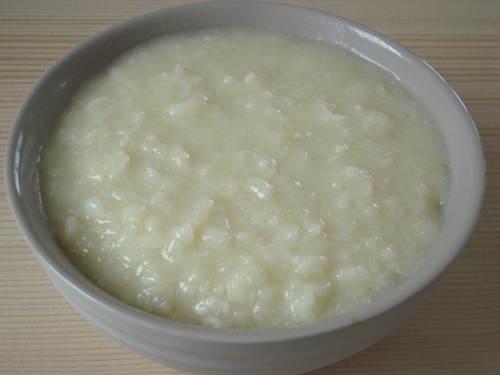
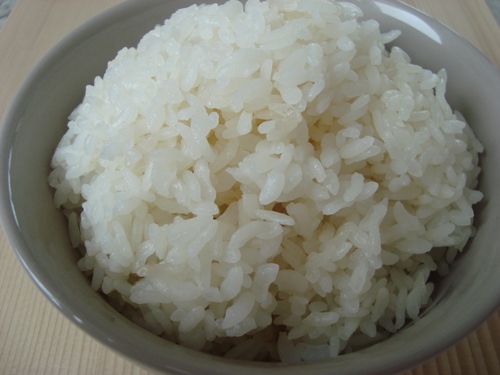

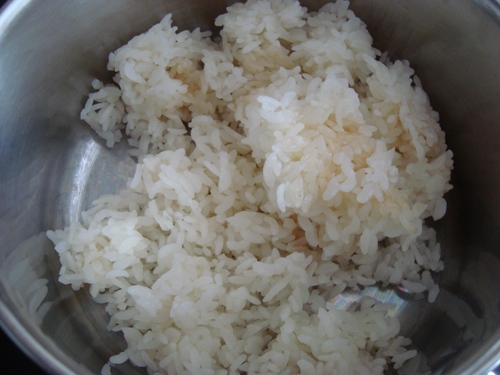
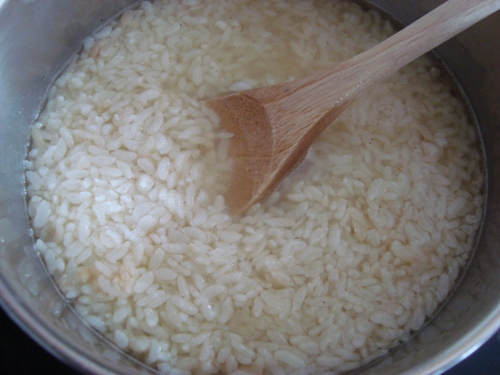
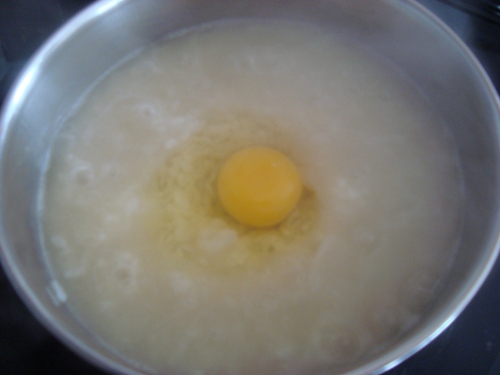
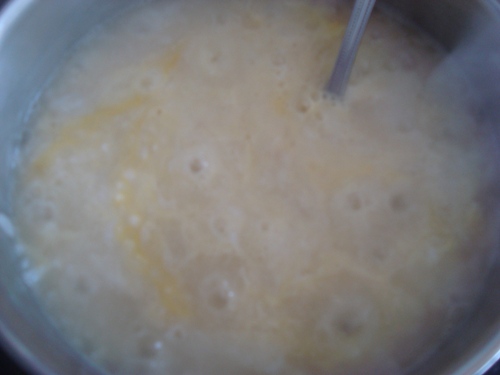
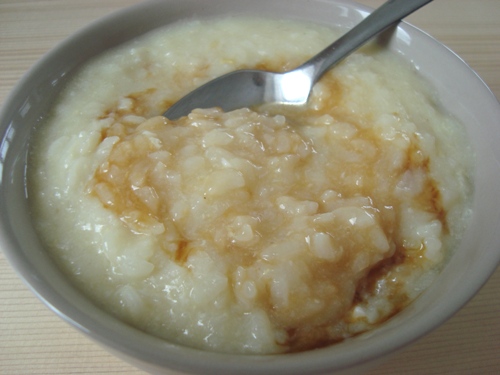




Comments
rice pudding - sweet version
Also very comforting -
Ing: cooked rice + milk to cover + inch (never tried - but possibly works with coconut liquid), brown sugar (or honey)
Prep: simmer patiently and stir until thick. (no patience? - thicken with a little flour)
serve hot or cold as dessert
garnish:
sprinkle cinnamon sugar
or
trickle a few drops sweet rose water (Lebanse), cranberry syrop etc.
Orly
Israel
porrige
My Mom always made sweet porrige and I actually loved it / I recently made potato soup when I had a bad reaction to anti-biotics. It was just instinct and it is wonderful and does soothe you M.Y.
Rice porridge
I totally agree with you Dr. Ben Kim. In Malaysian culture, rice porridge is always eaten when one is feeling under the weather especially when having an upset tummy. It is a dish served in hospitals & even in the breakfast menu of 5 star hotels.
The consistency is either grainy or thick ( mashed up grains).
We serve our porridge with pickled radish, fried anchovies, peanuts or salted egg.
Its yummy!
Rice Porridge
Thank you so much for posting this. I have a grand daughter with IBS and she had just had an horrific attack ending up in the hospital when I saw this article so I called with info of how to make it as she doesn't have a computer to see your instructions. She made this and finally found something her stomach could tolerate. 3 days later she is extremely pleased at her progress and we owe it all the you Dr. Ben Kim as she is out of pain using this lovely recipe. Thanks ever so much for all the information you share. God bless.
pancreatitis
i googled rice soup and thankfully came up with your link. a korean doctor use to come to see me at home (i have MS) and also recently developed pancreatitis from meds & high triglycerides. (over 600) and although i'm slender ive had a host of health issues since being laid up. i remmebered Dr Lee's rice soup rcommendation and havent had it since last year so was searching for it to have since i cannot eat and barely drink liquids this week due to the inflamed pancreas.
thank you for putting this on your website my 'help'er just made it for me since husband is busy at work and i am unable to be upright for any length of time. but i was actually able to stomach it inspite of the serious issues goin on inside my abdomen.
when i'm feeling better from this i will try other recipes you have so nicely included.
thanks to you dr Kim :)
sincerely
suzanne
MS & LDN
Suzanne, I couldn't help but notice that you wrote that you are an MS sufferer. I gently but strongly urge you to please check into the work of Dr Bernard Bihari, MD and his work with LDN - Low Dose Naltrexone which his research has shown works well for a variety of ills, most notably MS & cancer but also other problems too. Myself, I was dxd with Hashimoto's Autoimmune Thyroidits, an autoimmune disease wherein the immune system eventually destroys the thryoid gland so hypothyroidism is the primary symptom; also FMS/CFS too, and possibly also Leaky Gut Syndrome, systemic candida &/or latent lyme but can't afford to get tested for nor treated for these on top of everything else. Anyhoo, on May 1/13, I started taking 4.5 mg of LDN @ bedtime per Dr Bihari's suggested protocol and confess it's making a HUGE difference in my life already! Despite being under chronic stress since mid-May due to an ongoing problem with a senior rescue dog here at home, the chronic stress of which is compounded by a chronic lack of sleep and both of which would normally have had me sicker n' a dog LONG before now, but, I've not gotten sick yet even once since starting my nightly dose of LDN! Anyhoo, there's a free online group on yahoo.com called LDN Users and there's a lady on there with MS who swore to me that going on it was the best thing she ever did for herself! It doesn't hurt to at least look into it, what have you got to lose but some time? Sending zen, healing thoughts and prayer your way:-) Mare, S. Ontario, Canada
Hashimoto's/LDN
Hi Mare, I too have Hashimoto's and had heard about LDN therapy. I too live in Ontario, Toronto to be precise, but my GP had never heard of it and was reluctant to give it a try. How did you overcome the hurdle of getting it prescribed?
Hashimoto's/LDN
Hi Sylvia Tam, I was fortunate at the time to have a doc with an open mind but sadly (& unjustly to my & many of his other patients' minds:-( he was basically forced into retirement this March by 'the big shots' that oversee physicians in Ontario as they do not have open minds nor do they care that he was actually helping people:-((((( *NB: these are MY thoughts & words on the subject, not his). Unfortunately for me, LDN only worked for me for about 4-5 months. According to the research I've read since then, if one has underlying adrenal problems &/or untreated infections such as systemic candida, parasites, mold, lyme, etc. (which I believe I do have but can't afford to properly test nor treat), then LDN often won't work or else will only work for a short time as it did with me. Turns out my doc didn't follow the proper protocol though as put forth by the doc who first discovered the benefits of LDN and instead he started me out at the highest dose of 4.5 mg right off the bat. Apparently one is supposed to start at 1.5 mg and slowly work up from there to the max of 4.5. Anyhoo Sylvia, if you go to this link...https://www.ldnscience.org/patients/find-a-doctor and type in your country and city, you'll find there is one Toronto doc listed, ok? Best of luck to you Sylvia, hope you can get it and that it helps you! There are some yahoo & facebook LDN groups, esp one I believe is called Healing Hashimoto's with LDN on facebook. Peace, Mare
Rice Porridge
Dr Kim,
I never thought to use cooked rice but I do grind up raw rice in my blender and then cook it like a hot cereal. It comes out very creamy and I like it with cinnamon & honey...that's my sweet tooth coming out. I'll try it with broth some time too.
Frozen rice
I've not tried this method, but was told that freezing uncooked rice will yield very fine smooth porridge. And it takes less time to get the desired texture.
Indian version of porridge
Hello,
This reminded me of my childhood days when feeling under the weather , mum used to make a similar porridge for me. The only difference is that instead of using eggs , she used lentils and rice .
It was then cooked with a dash of salt and while hot she served with plain yoghurt ( best at room temperature) . Yumm....I wish mum was here ..I still think she makes it the best. COuld it be because she adds that secret ingredient ..... "mother's love"?
I lived and worked in
I lived and worked in Thailand for six months last year. One public holiday weekend I got very dehydrated and ill generally. I went to one of the neighbourhood "Mom and Pop" stores to see if I could find anything to eat. The Thai grandma behind the counter couldn't speak any English but she could see I was unwell and immediately spooned me up a bowl of chicken jok. It was so good! I went back a few more times during the next few days.
Omo!!!
I've been dying to make this, but recipes I saw were too complicated (blend raw rice, etc.). This was AMAZING!!! Besides the eggs, I put in soy sauce, garlic, sesame oil, pine nuts, and sesame seeds (too much?). Haven't been feeling well, and that hit the spot. Thank you!
Thanks for posting this Dr.
Thanks for posting this Dr. Ben. As an Asian, i know how to make it but never tried it with eggs though. My grand mother used to make it with cooked rice, water, salt, garlic and coconut milk. My mother makes it with row brown rice grind with water, add chopped garlic and salt and cook it. Half way through she adds coconut milk and brings to a boil. I showed her your way of making it and will try it out thanks.
Love the rice porrige!
Thank you for a very delicious and easy on the stomach breakfast that the whole family enjoyed. We didn't have any broth on hand so we added a small handfull of organic fresh raspberries and a dash of milk to cool temperature for my 19 month old son to eat immediately. Flavour wad not eggie at all, quite creamy and very yummy. Will try next time using vegetable broth for added minerals. Oh, a little sea salt was added for flavour. My belly is feeling great and satisfied!
rice
I love white and brown rice, but brown rice at times can leave both my daughter and I very nauseated, even when soaked for a long time. I find the almost hysterical fear of white rice to be sort of silly, whole chunks of the world have been eating a lot of it, for a very long time - and survived. And since my family and I eat other foods along with our rice, I don't tend to worry about it needing to be a main source of protein. I've never really liked bread or pasta much - hate sandwiches. And when I found Asian dramas on Hulu, it dawned on me - there sure are a lot of good foods made to eat with rice. And I like a lot of the asian noodles - texture is nice. So, I hit the asian food market and haven't looked back. Instead of eggs and toast for breakfast - it's egg soup and rice. Sticky rice and mango, or rice coconut cake and the like for dessert. The interesting thing is I have lost 8 pounds, without ever really trying. Never once felt deprived, I think chili paste is probably heaven-sent. My stomach is rarely upset anymore.
Been wanting to try rice porridge using leftover rice, thanks for the recipe.
rice coconut cake
The rice coconut cake sounds delicious and would do for a dessert for me. Do you have a recipe? I'm whey, soy and gluten intolerant and looking for great recipes using alternative ingredients. I just recently found teff and injeera for others in the same situation.
When I was in Acupuncture school we learned to put healing herbs in congee and a Malaysian restaurant used to put dark solid duck eggs as well as a small amount of pork in their congee and it was wonderful.
Making it even easier
An even easier way to prep rice porridge recipes is to use the crockpot. The slow-cooker has always worked well for me when making congee. I start with uncooked rice, add water, and leave it plain to develop in to sweet or savory as needed. Sometimes I make a whole pot of sweet or savory but usually I make plain to leave me flexibility.. Whichever way is always super easy and very hands free in the crockpot!
And I too have experienced weight loss by routinely eating this porridge. Not my intention but a nice perk.
Rice porridge
Rice porridge or pudding is always soothing. A great quick to go recipe when needing a simple meal even. Being vegan, no eggs, but make it sweet or savory depending on the mood.
Khichadi
Khichadi is an Indian dish that contains a combination of rice and lentils. Khichadi is commonly considered to be India’s comfort food and is primarily a very plain dish that is normally associated with bland taste and diet for people when sick. Khichadi is also the first solid food that babies are introduced to.
Ingredients
1 cup white rice, washed in water and drained
1 cup yellow lentils (also known as yellow moong dal), washed and soaked in water and drained
About 4 cups of water
1/2 (half) teaspoon cumin seeds
1 teaspoon oil
Salt to taste
Method
Step 1
Heat oil in a heavy-bottomed pot. (Preferably one with a cover, which will be able to contain the amount of rice and lentils cooked.)
Step 2
When oil is hot, add cumin seeds. Allow cumin seeds to splutter but do not let them get burnt.
Step 3
Fold in the yellow lentils and rice. Mix cumin seeds thoroughly with the lentils and rice.
Step 4
Stir in water and salt.
Step 5
Bring to boil.
Step 6
Lower the heat, partially cover the pot and cook until the rice is cooked.
Step 7
Serve hot with a sprinkling of coriander. This dish can also be served with some plain yoghurt. Khichdi can also be cooked in a pressure cooker or in a microwave. In both cases, the cooking time should be reduced to about 20 – 30 minutes.
Variations :
Other ingredients such as spices or vegetables can be added to the khichadi. These can be experimented with to vary the taste of the final dish.
This is what I do:
Good topic for folks with digestive issues. I don't have any stomach problems, virtually never do, but to make rice porridge for the heck of it, I put the cooked white rice into an electric grinder - the slow-moving, single auger type. You then don't have to cook it for long as it's already mushy and more digestible.
thanks
I have severe digestive issues (3 surgeries, 13 egds) and I really am in need of something easy and somewhat nutritious to eat when i get a flare up. This is perfect. It will go down my esoph easy and be easy to digest! I have been looking for a good recipe since i heard of jook and this one wins! Thanks again.
Thanks!
Struggling with the changes that were made, physically, medically, cognitively and psychologically at 28 ... learning to live with the fact that I take medications to keep me alive ... then random thing started to happen ...
I was hospitalized for low blood sugar; low salt; twice for ridiculously high lipase levels
I have been diagnosed with adrenal insufficiency, diabetes incipidis, seizure disorder; pancreatitis; gastroparesiss; stomach ulcers
So here I am trying foods out on a gastroparesis diet that fit with me being a vegetarian for over 20 years and my lactose, soy, gluten intolerances.
I have tried store bought "cream of rice" cereal and spit it out (yuck). Normally prepared rice is too heavy and sits in my stomach. Today in my failed attempt to make rice milk, and not wanting to waste anything ... I put the soupy rice in my refrigerator. I went online to brain storm.
I cooked my rice normally (1:2 ratio). After steaming I put 4 more cups of water, stirred and let the mixture sit until it was warm. I used my immersion blender and yet added another 1 cup of water (I was trying to make rice milk...). I later realized that this COULD work as a porrage/soup ... like Ochazuke (being Japanese American ... sticky rice in gemma cha tea ... no chicken soup for me). I put it in my soup pot with a pinch of salt, warmed it up and yum (maybe my other method for rice milk will work out!)
I like to add matcha to mine.
I like to add matcha to mine.
This looks really good. I
This looks really good. I don't eat too much white rice, so I may try it with brown. Although I'm sure white rice porridge is delicious.
I've been looking for foods/recipes that increase yang energy and saw rice porridge listed as being helpful for this. This is simpler than I thought and I cannot wait to make it with broth. I read this can also be made as a desert, with a little cinnamon, sugar and nutmeg.
rice porridge
I am going to try to make this as I suffer from lymphocytic colitis and there are few things I can eat without a problem I now also have heart problems and COPD. I think my body is lacking nutrients due to the constant colitis. Due you suggest anything easy on the system to add to the rice? I have followed your e-mails for several years.
Don't know about your
Don't know about your specific condition, but I grew up in Singapore where a version of watery porridge has soft chunks of sweet potato. Imagine a ratio of less than half a sweet potato per person or big bowl of porridge.
I recently discovered, after
I recently discovered, after looking for a change from oatmeal, that Bob's Red Mill makes a brown rice cereal - it's just ground brown rice. Ignore their instructions for using 3 cups of water, though - it needs 4 cups. It only takes 10 minutes to cook.
Here in the Philippines rice
Here in the Philippines rice porrige or "lugaw" as we call it is a staple breakfast and a healing dish for stomach upset. We saute some ginger, onions and garlic with shreds of leftover chicken or fish, then add cooked rice and water before bringing into a boil. The consistency we prefer though is not so thick. Sometimes we garnish it spring onions and slices of hard-boiled eggs. It's truly satisfying!
Rice porridge
This reminds me of Congee. We use various toppings along with the rice: pork or chicken pieces, cilantro, scallions, fried onion or garlic etc.
Rice Porridge
I grew up on Chinese style "chok" (sounds like it's similar to Korean jook) rice porridge and still use it for convalescent food. One variation that I'm aware of but haven't tried yet is to have cubes of sweet potato in it. The rice porridge is still savory (add salt) but the sweet potato would add a touch of sweetness, some fiber and extra nutrients. Currently, I usually make a big batch and then vary my individual servings, eg. flavor with simple Chinese style meatballs (ground pork, sesame oil, soy sauce and beaten egg to bind) dropped into simmering porridge. Or fresh sliced fish or chicken. It's a one pot wonder meal.
Broth
Hi, Dr. Kim. You mentioned "broth" in this recipe, and also in one some time back, can't recall which. Just curious what kind of broth you would recommend -- chicken, beef, vegetable, cubes? Be nice to know.
Thanks,
Chad
Hi Chad,
Hi Chad,
I use whatever type I have on hand, usually vegetable broth. But all other types should work equally well.
Ben
Broth
Thanks, Dr. Kim! Most of my recipes for jook call for chicken stock, but as I live in an area with a large Korean immigrant population, I'm trying to learn more about the cooking traditions.
Rice Porridge
Just what I need today, after an attack by a particularly vicious stomach bug! Thank you! You always seem to be there to rescue me when I need it!
Incidentally, well cooked white rice and chicken works on dogs too, when they escape and scavenge in the neighbour's compost heap!
congee is called 'jook' in
congee is called 'jook' in both Korean and Cantonese Chinese culture.
Before colonoscopy
It was written somewhere that it is preferable to avoid fibers 3 days before a colonoscopy. This recipe is just the thing to replace an oatmeal breakfast!
Thank you!
Rice Porridge change up
First off I love the rice porridge recipe as is. Became a staple for me when I was first diagnosed with Celiacs in 2016. I am most grateful to you and your site.
Recently, I have introduced buckwheat to my diet, for increased protein & amino acids. On a whim, I decided to substitute the buckwheat for the rice. I had to add a little more bone broth but it tastes fantastic.
Amazing versatile recipe, marvelously informative website & quality products. I cannot thank you enough for all that you do.
Rice porridge
Hello Dr Kim. I always read your emails with great interest. Last night I happened upon this one about rice porridge. It came just in time as I was suffering terribly with severe heartburn/upset stomach from phos binder pills I must take as I am on dialysis machine for failed kidneys due to PKD. I was so ill and made plain mashed white rice ( sorry, didn't follow recipe exactly). I immediately felt better 100% and slept easy thru the night. I will from now on always eat this porridge or white rice as part of meals. Thank you so very much !!
Best regards..Lisa
Very glad to know, Lisa,
Very glad to know, Lisa, thank you for sharing! - Ben
Rice Porridge
Thanks for the article. You mention rice porridge in Korean and Chinese cultures. Recently, I had a bowel obstruction and, when I finally returned to eating "food," the first thing I had was rice porridge. I had learned about it when I lived in Japan, where they call it "okayu." Once I start feeling a little bit better, I love adding "gohan desuyo" to it. Yum!